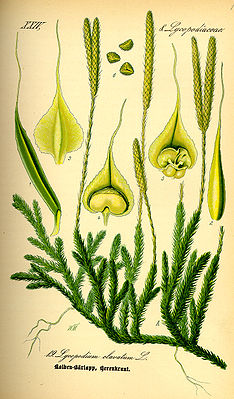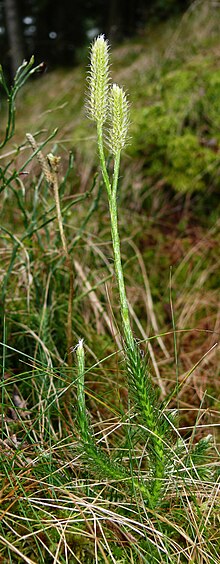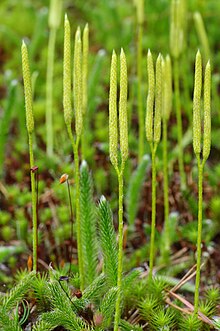Club mackerel
| Club mackerel | ||||||||||||
|---|---|---|---|---|---|---|---|---|---|---|---|---|

Club moss ( Lycopodium clavatum ssp.clavatum ), illustration |
||||||||||||
| Systematics | ||||||||||||
|
||||||||||||
| Scientific name | ||||||||||||
| Lycopodium clavatum | ||||||||||||
| L. |
The club moss ( Lycopodium clavatum ), also known as wolf's claw , is one of the vascular pore plants . The name is made up of the Greek lycos = " wolf " and pos = "foot", probably because the densely leafed branches are remotely similar to an animal's foot. Latin clavatum = " club ", denotes the shape of the spore stands.
features
The perennial and poisonous plant consists of a sprout that is between 0.5 and 4 meters long and creeps on the ground and upright side branches up to 30 cm. The needle-like leaflets are dense and have hair one to three millimeters long at the tip of the leaf. This hair makes the plant appear furry, which has given it the name Wolf's Claw. The sporophyll stands are arranged in yellow ears at the end of upright branches and appear from July to August. The ears are made up of specialized leaflets with the spore receptacles in their axils . Unlike the herb, the spores probably do not contain any alkaloids . The spores are not known to have a toxic effect.
The chromosome number of the species is 2n = 68.
ecology
The club bear is a chamaephyte , a creeping perennial. They grow through groups of initial cells. Root hairs are missing, but VA mycorrhiza is present. The pre-germ and the subterranean young plant parasitize on a fungus of the genus Glomus . The plants only reach sexual maturity after 10–15 years.
The spores are expelled in yellow clouds and spread out by the wind as a granular flyer; they have a descent speed of 2 cm / s, and thus they reach flight distances of 300 km and more. Spore ripening is in October.
The spores only germinate after 6–7 years and form a tiny pre-germ ( gametophyte ). On this are both male and female germ cells ( gametes ) that fertilize each other. Only then does the actual bear moss plant ( sporophyte ) form. One speaks of a generation change.
The vegetative reproduction is predominant in this species. It takes place over long runners .
Ingredients, toxicity, use
The herb ( Lycopodii herba ) contains the curare- like, poisonous alkaloids lycopodine , annotine , clavatin , clavononine , fawcetin and lycoclavine , the concentration of which can apparently vary greatly depending on location and breed. 0.2 g of the herb is fatal to mice and frogs .
The herb used to play a major role in folk medicine , but is no longer of any importance in conventional medicine , as its effectiveness has not been proven.
The following ingredients have been found in the spores : fatty oil , polyterpenes such as sporonin , but only traces of alkaloids.
In the past, bear moss spores were used in pharmacies as a release agent in the manufacture of pills. This application is no longer recommended because they allergies can trigger the immediate type that lead to asthmatic symptoms.
The following uses of Lycopodium spores are still described today: Fire-breathers use the spores as a substitute for fire-breathing fluid, since club moss spores are far safer and less harmful. If you “spit” (= atomize) the spores against a flame, enormous fireballs are created. Lycopodium is also used for fire effects in theater and pyrotechnics.
In criminology , the spore powder is used together with Argentorat to make fingerprints visible. It is used to coat rubber gloves and dry condoms.
Lycopodium is used as a constitutional remedy in homeopathy .
Lycopodium clavatum spores are used to produce test aerosols .
Occurrence
This species can be found on lime-free, barren soils in coniferous forests, heaths and grasslands; seldom also in deciduous forests. She avoids deep shadows and great moisture. In Central Europe it is a genistion association character.
It is common throughout Central and Northern Europe, but also in Russia , Asia , America and even in the mountains of tropical Africa . In the Allgäu Alps, it rises in Vorarlberg at Diedams-Sattel and between Hochkrumbach and Haldenwanger Eck up to 1800 m above sea level.
particularities
Endangered in Germany according to the Red List .
Systematics
In Austria two subspecies are distinguished:
- Common club moss ( Lycopodium clavatum subsp. Clavatum ): With 3–6 cm long sporophyll stands; occurs in all federal states.
- Ptarmigan club club ( Lycopodium clavatum subsp. Monostachyon (Grev. & Hook.) Selander , Syn .: Lycopodium clavatum var. Monostachyon Grev. & Hook. ): With 1–2 cm long, individually seated sporophyll stands. Rarely in the Gurktal Alps , Seetal Alps , Hohe Tauern and Niedere Tauern . The clan is potentially endangered.
literature
- Bernhard Marbach, Christian Kainz: FSVO nature guide mosses, ferns and lichens. BLV, Munich 2002, ISBN 3-405-16323-4 .
- Wolfgang Adler, Karl Oswald, Raimund Fischer: Excursion flora of Austria . Ed .: Manfred A. Fischer. Eugen Ulmer, Stuttgart / Vienna 1994, ISBN 3-8001-3461-6 .
- Ruprecht Düll , Herfried Kutzelnigg : Pocket dictionary of plants in Germany and neighboring countries. The most common Central European species in portrait. 7th, corrected and enlarged edition. Quelle & Meyer, Wiebelsheim 2011, ISBN 978-3-494-01424-1 .
- Roth / Daunderer / Kormann: Poisonous plants, plant poisons. 4th edition.
- Ingrid and Peter Schönfelder : The new manual of medicinal plants , Franckh-Kosmos Verlagsgesellschaft, 2011, ISBN 3-440-09387-5 .
- Teuscher, Lindequist: Biogene Gifte, Biologie, Chemie, Toxikologie, 3rd edition, 2010, ISBN 978-3-8047-2438-9 .
- K. Hiller, MF Melzig: Lexicon of medicinal plants and drugs. 2nd Edition. 2010, Spektrum Akademischer Verlag, ISBN 978-3-8274-2053-4 .
Individual evidence
- ↑ a b Erich Oberdorfer : Plant-sociological excursion flora for Germany and neighboring areas . 8th edition. Stuttgart, Verlag Eugen Ulmer, 2001. P. 66. ISBN 3-8001-3131-5 .
- ↑ Andrea Gärtner, Leander Mölter, Andreas Gessner: Characterization of an impinger for the emission measurement of microorganisms. In: Hazardous substances - cleanliness. Air . 68, No. 9, 2008, ISSN 0949-8036 , pp. 351-356.
- ↑ Erhard Dörr, Wolfgang Lippert : Flora of the Allgäu and its surroundings. Volume 1, IHW, Eching 2001, ISBN 3-930167-50-6 , p. 95.
Web links
- Club mackerel. In: FloraWeb.de.
- Club mackerel . In: BiolFlor, the database of biological-ecological characteristics of the flora of Germany.
- Profile and distribution map for Bavaria . In: Botanical Information Hub of Bavaria .
- Lycopodium clavatum L. s. l., map for distribution in Switzerland In: Info Flora , the national data and information center for Swiss flora .
- Distribution in the northern hemisphere from: Eric Hultén, Magnus Fries: Atlas of North European vascular plants , 1986, ISBN 3-87429-263-0 .
- Distribution of Lycopodium clavatum subsp. monostachyon in Switzerland [1]
- Thomas Meyer: Bärlapp data sheet with identification key and photos at Flora-de: Flora von Deutschland (old name of the website: Flowers in Swabia ) .



